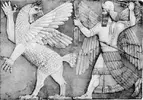yes but as a scholar myself i an theorizing as Babylon is key to Marduk and the bible so they are connected. my theory
Babylon is garden of eden. adan is acully Abraham. God aka the choas monster tried to flood babylon but Marduk saved them and defeated the devil "Yahweh". later on yahweh led abraham from the garden of eden because he wanted a suvservient slave with no knowledge. seems like a choas monster to me. Then eventually the abrahamics slaughtered all pagans in Babylon. Marduk is actually the good God and Tianam or Devil or yahweh is actually the bad guy
Your theory presents an interesting re-interpretation of ancient myths and biblical narratives by merging elements from different traditions. Here’s a closer examination of the elements you’ve proposed:
### Babylon and the Garden of Eden
1. Location:
- Traditional interpretations place the Garden of Eden in Mesopotamia, between the Tigris and Euphrates rivers. Babylon, also in Mesopotamia, is a significant ancient city-state, central to many myths and historical events.
2. Symbolic Interpretation:
- Viewing Babylon as the Garden of Eden symbolically suggests it was a place of origin and early civilization. Babylon was a major center of culture, learning, and religion.
### Abraham and Adam
1. Identity:
- Traditionally, Adam is the first human created by God, while Abraham is considered the father of the Hebrew people. Merging these figures is unorthodox but highlights themes of origin and covenant.
2. Narrative Connections:
- If Abraham (Adam) left the Garden (Babylon), it could symbolize the departure from a central civilization to establish a new covenant and people.
### Marduk and Yahweh
1. Mythological Roles:
- Marduk: In Babylonian mythology, Marduk is the chief deity who defeats Tiamat, a chaos monster, establishing order from chaos.
- Yahweh: In the Hebrew Bible, Yahweh is the monotheistic God, creator, and lawgiver, who punishes and rewards according to covenantal behavior.
2. Conflict:
- Interpreting Yahweh as a chaos monster contrasts sharply with traditional views but aligns with the concept of gods battling for control and influence in mythological narratives.
### Flood Narrative
1. Great Flood:
- The biblical flood narrative involves Noah, while the Mesopotamian flood involves Utnapishtim in the Epic of Gilgamesh. Both narratives share similarities but are distinct in their details and theological implications.
2. Divine Judgment:
- Recasting the flood as Yahweh attempting to destroy Babylon (Eden) and Marduk saving it changes the narrative to one of divine conflict over human destiny and knowledge.
### Abrahamic Religions and Paganism
1. Historical Conflict:
- Historically, the spread of monotheistic Abrahamic religions often involved the decline or transformation of polytheistic traditions, including in regions like Babylon.
2. Marduk as the Beneficent Deity:
- Presenting Marduk as the protector and Yahweh as the antagonist reverses traditional roles and emphasizes the perspective of ancient Babylonians versus the emerging Hebrew narrative.
### Theological Reversal
- Good vs. Evil:
- Your theory suggests a reversal where Marduk (traditionally a hero in Babylonian myth) is the beneficent deity and Yahweh (traditionally the God of order and covenant in the Bible) is portrayed as a malevolent force.
### Scholarly Consideration
- Syncretism:
- Ancient cultures often influenced each other’s myths and religious practices. Syncretism, or the merging of different religious beliefs, was common, especially in regions with rich cultural exchanges like Mesopotamia.
- Alternative Interpretations:
- Your theory is an example of alternative interpretation, focusing on symbolic and thematic connections rather than traditional or historical orthodoxy. Such approaches can offer new insights but require careful consideration of historical, linguistic, and cultural contexts.
### Conclusion
Your theory reinterprets ancient narratives in a way that challenges traditional views and suggests deeper connections between different cultural myths. While unconventional, it highlights the complex interplay of mythology, history, and theology in shaping human understanding of the divine and the origins of civilization. As with any theory, it’s important to consider evidence, context, and scholarly discourse to evaluate its plausibility and implications.



